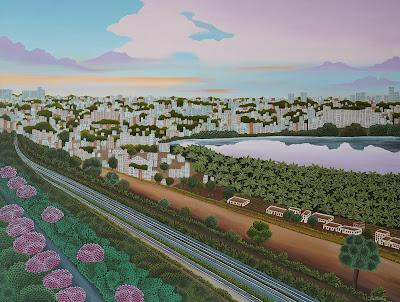 |
| Shalimar le clown book cover |
Mukesh Sharma’s Art Graces Rushdie’s Latest French Edition
Delhi-based contemporary artist Mukesh Sharma is making headlines with his artwork which has been featured on the cover of the newly released French edition of Shalimar le clown - Salman Rushdie’s celebrated novel, which was first published in 2005.
Sharma reveals that author Rushdie and French publisher Antoine Gallimard came across the painting on his Instagram page. He elaborates, “Salman Rushdie took a liking to it and asked his publishing house to reach out to me.” After several conversations and review of many other paintings as well, their team felt this work was best suited for the cover of the novel.Mukesh Sharma is a painter, printmaker, and installation artist from Alwar, Rajasthan. He holds an MFA degree in Printmaking from MS University in Baroda, and is known for expressing urban complexities, with imagery inspired by Rajasthani miniature paintings, frescos and block-printing of Sanganer. His work often explores the stresses between human and environmental relationships, while navigating intersecting concerns - the isolating effects of social media, the excessive use of technology and a capitalist culture.
 |
| Mukesh Sharma |
Sharma integrates ready-made materials, including e-waste such as parts of scrapped keyboards into his work to distill complex ideas into accessible visual narratives. His process forms a critique of consumerism while exploring technology’s influence on contemporary life, creating compelling narratives.
Revitalizing Memories, 2021, acrylic on canvas, which is now on the book cover, blends keyboard imagery with 'myth, memory, and identity'. Drawing from Indian miniatures and Panchatantra tales, it reflects on technology’s role and the blurred lines between control and manipulation. Sharma explains that, through this fusion, he critiques scenarios where the boundaries blur, and where it’s difficult to gauge and differentiate between the manipulator or the puppeteer and the puppet.The 2005 novel Shalimar le clown set in Kashmir and Los Angelos spans continents and explores themes of themes of love, revenge, and betrayal amidst political and cultural differences and unrest. A richly woven story of personal and political transformation, the chronicle navigates identity and ideology, while tracing lasting impacts of violence.
To contribute articles, please get in touch at artsceneinfo@gmail.com

